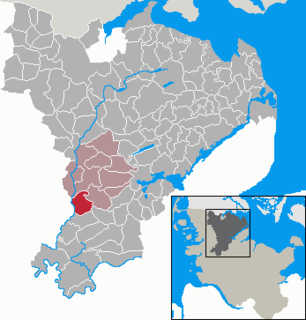
Schleswig-Holstein is the northernmost of the 16 states of Germany, comprising most of the historical duchy of Holstein and the southern part of the former Duchy of Schleswig. Its capital city is Kiel; other notable cities are Lübeck and Flensburg.

Southern Schleswig is the southern half of the former Duchy of Schleswig in Germany on the Jutland Peninsula. The geographical area today covers the large area between the Eider river in the south and the Flensburg Fjord in the north, where it borders Denmark. Northern Schleswig, congruent with the former South Jutland County, forms the southernmost part of Denmark. The area belonged to the Crown of Denmark until Prussia and Austria declared war on Denmark in 1864. Denmark wanted to give away the German-speaking Holsten and set the new border at the small river Ejderen. Prussian chancellor Otto von Bismarck concluded that this justified a war, and even proclaimed it a "holy war". He also turned to the Emperor of Austria, Franz Joseph I of Austria for help. A similar war in 1848 had gone poorly for the Prussians. With Prussia's modern weapons and the help from both the Austrians and General Moltke, the Danish army was destroyed or forced to make a disorderly retreat. And the Prussian-Danish border was moved from the Elbe up in Jutland to the creek Kongeåen.

The Duchy of Schleswig was a duchy in Southern Jutland (Sønderjylland) covering the area between about 60 km north and 70 km south of the current border between Germany and Denmark. The territory has been divided between the two countries since 1920, with Northern Schleswig in Denmark and Southern Schleswig in Germany. The region is also called Sleswick in English.
Steinburg is a district in Schleswig-Holstein, Germany. It is bounded by the districts of Dithmarschen, Rendsburg-Eckernförde, Segeberg and Pinneberg, and by the Elbe River.
Pinneberg is a district in Schleswig-Holstein, Germany. It is bounded by the districts of Steinburg and Segeberg, the city of Hamburg and the state of Lower Saxony. The island of Heligoland is also part of the district.
Stormarn is a district in Schleswig-Holstein, Germany. It is bounded by the districts of Segeberg and Ostholstein, the city of Lübeck, the district of Lauenburg, and the city-state of Hamburg.

Holstein is the region between the rivers Elbe and Eider. It is the southern half of Schleswig-Holstein, the northernmost state of Germany.

Brunsbüttel is a town in the district of Dithmarschen, in Schleswig-Holstein, northern Germany that lies on the mouth of the Elbe river, near the North Sea. It is the location of the western entrance to the Kiel Canal, the busiest artificial waterway in the world.

Achterwehr is a municipality, located in the district of Rendsburg-Eckernförde in the German Bundesland of Schleswig-Holstein.

Aumühle (German: [aʊ̯ˈmyːlə] is a municipality in Schleswig-Holstein in northern Germany, about 21 km east of Hamburg. Its Friedrichsruh district is home to the family estate and mausoleum of Otto von Bismarck.

Rissen is a quarter of the city of Hamburg in Germany. It is located in the borough of Altona and is the westernmost quarter in the Hamburg, bordering the German federal state of Schleswig-Holstein in the west, north, and northeast and the Elbe river to the south. In 2016, the population was 15,000.

The Duchy of Holstein was the northernmost state of the Holy Roman Empire, located in the present German state of Schleswig-Holstein. It originated when King Christian I of Denmark had his County of Holstein-Rendsburg elevated to a duchy by Emperor Frederick III in 1474. Members of the Danish House of Oldenburg ruled Holstein – jointly with the Duchy of Schleswig – for its entire existence.

Eilbek (help·info) is a quarter of the German city of Hamburg and part of the Wandsbek borough. It originated as a small village on the outskirts of Hamburg and was eventually incorporated when the city expanded. In 2016 the population was 21,505.

Hollingstedt is a municipality in the district of Schleswig-Flensburg, in Schleswig-Holstein, Germany, located on the Treene river.

Hamwarde is a municipality in the district of Lauenburg, in Schleswig-Holstein, Germany.

Witsum is a municipality on the island of Föhr, in the district of Nordfriesland, in Schleswig-Holstein, Germany.
Holstein-Glückstadt or Schleswig-Holstein-Glückstadt is the historiographical name, as well as contemporary shorthand name, for the parts of the duchies of Schleswig and Holstein that were ruled by the Kings of Denmark in their function as dukes of Schleswig and Holstein, thus also known as Royal Schleswig-Holstein. Other parts of the duchies were ruled by the Dukes of Schleswig-Holstein-Gottorp. The territories of Holstein-Glückstadt are located in present-day Denmark and Germany. The main centre of administration was Segeberg and from 1648 Glückstadt on the River Elbe.

Alsterdorf is a quarter in the Hamburg-Nord borough of the Hamburg, Germany. The name has its origin after the river Alster which become later the dams Außenalster and Binnenalster in the center of Hamburg. In 2016 the population was 14,428.

Nienstedten is a quarter in the city of Hamburg, Germany. It belongs to the Altona borough on the right bank of the Elbe river. Nienstedten is home to the International Tribunal for the Law of the Sea. In 2016 the population was 7,238.

Wellingsbüttel, a quarter in the Wandsbek borough in the city of Hamburg in northern Germany, is a former independent settlement. In 2016 the population was 10,506.
















